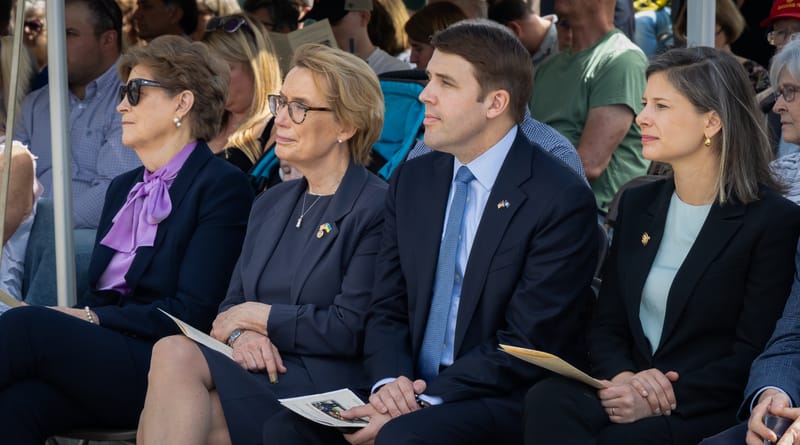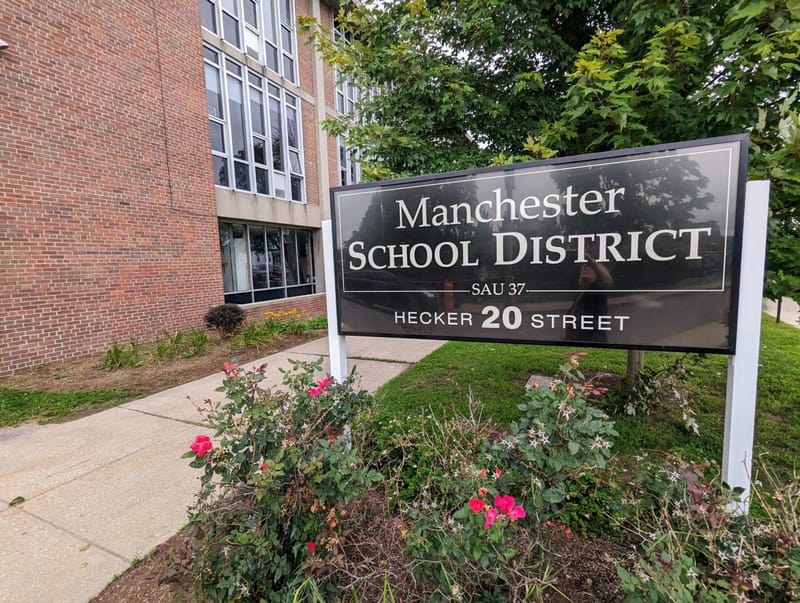Systemic Flaws: Examining the grim reality of New Hampshire’s child abuse and neglect
I am of the belief that our population, not only in New Hampshire, but across the country, we have such high mental health problems because of being exposed to adverse childhood experiences at such high rates — 55% to 65% of us have been exposed to at least one childhood adversity — we need mental

Click above to watch the full episode of The State We’re In.
Many horrific cases of child abuse have made headlines in recent months. Some of them have been going on for years. From the Harmony Montgomery trial to the ongoing Sununu Youth Services Center case, these tales have been pretty chilling. As the worst of these cases expose gaps in the system, dozens of children die each year in New Hampshire. How do we stop this from happening again? Here to discuss this are Dr. Resmiye Oral, the section chief of the Child Advocacy and Protection Program at Dartmouth Health Children’s, and Cassandra Sanchez, the state’s Child Advocate.
This transcript has been edited lightly for length and clarity.
Melanie Plenda:
Can you talk to us briefly about your work and what it involves?
Cassandra Sanchez:
The Office of the Child Advocate is an independent state agency. We are mandated to provide for the best interest for children. We are oversight for executive branch state agencies that are child-serving. Any executive branch state agency that either directly provides services to children or contracts with providers, for those providers to give the services to our children, we have the ability of oversight of those entities and ensure that they are providing for the best interest of children, keeping their well being in the forefront and meeting the needs of children across the state of New Hampshire.
There are many different ways where information comes to the Office of the Child Advocate, one of which is direct reporting, which is required through our statute, from certain agencies, such as restraint and seclusion reporting for children that are in residential placement or incident reports of serious injury to children. We may see issues in those reports, and we have to address them directly with the agency, who is tasked with ensuring the safety of those children.
We also receive inquiries from the public directly into our office. What that means is that folks from the public may call if they have a concern about the way in which a state agency is servicing a child, or if they are seeking out services for themselves or their child and don’t feel that they are being appropriately assessed for those services. We do an independent look at what’s happening. The premise of our work is utilizing safety science. So it’s a no-shame, no-blame process. We are looking at it from the lens of the systemic view — how can we inform the overall system to best interest and providing adequate care to children?.
Dr. Resmiye Oral:
I am a child abuse pediatrician, and my program consists of multiple nurse practitioners, physicians, nurses, social workers and child life specialists who come together and provide multidisciplinary diagnostic evaluation services to victims of child abuse and neglect that are referred to us by a variety of agencies.
In doing so, we provide trauma-informed, trauma-sensitive, family-centered care to the clients who refer to our clinic. We also work with DCYF [the state Department of Children Youth and Families], to inform them, in our opinion, whether a child was abused and/or neglected or not, then guide them for services, and our team social workers will make referrals to community agencies for services both to the victim child and other family members.
Melanie Plenda:
Let’s talk about how big the problem is. What are some trends you have been seeing?
Cassandra Sanchez:
DCYF keeps their own data on the numbers of calls that they get in response to abuse or neglect, as well as their findings and substantiations. Our trends are more respective to the incident reports that we’re receiving — information that we learn about when we are either meeting with children or out in the community connecting with key stakeholders, as well as those incident reports that I spoke about already. So our trends shift and are maybe a bit different than what our child welfare agency is looking at.
One trend we found when we conducted a system review mapping in August of 2023 is that the office received inquiries about nine non-ambulatory infants — young infants who are not walking and crawling — who presented to emergency departments or physicians of some sort, with serious physical injuries, bruising, and oftentimes with further skeletal examinations, multiple broken bones and different stages of healing.
In New Hampshire, we’re seeing rising numbers of children presenting with mental health needs, parents as well. When we’re talking about parents’ mental health needs it’s important to also acknowledge stressors to parents in the day and age we are in now. There are a lot of stressors that our parents are facing, and it’s hard to have this discussion without acknowledging the societal climate in our country. There are heightened stressors for families. We find that that leads to the potential for abuse or neglect to children if protective factors are not in play. So that is another trend that we’ve been following very closely. knowing that the mental health crisis across the nation and in New Hampshire has not subsided and continues to increase year after year.
We did receive some cases from DCYF, particularly in our reviews of the DCYF work, where we found that they had filed in court, particularly for either abuse or neglect of children, and findings were not upheld by the court. That is a concern to us because it doesn’t mean abuse or neglect isn’t happening. When we reviewed some cases, we found that the facts of the case were there. What was missing was the understanding potentially on the court side or maybe in the explanation by the agency to help the court understand the impact to the child psychologically and emotionally, when abuse and neglect is happening. It may not be physical injuries that the child’s presenting with, or we’re talking about trauma that has a true impact to children. So that’s another concerning trend for us. Acknowledging that doesn’t mean the abuse or neglect didn’t happen. It just means the court did not substantiate those findings.
Dr. Resmiye Oral:
In New Hampshire, approximately 300,000 children are part of the entire population under age 18, and every year about 25,000 to 35,000 children are reported to DCYF for being a suspected victim of child abuse and neglect. So, if we take an average of 30,000 calls to DCYF, we may say about 10% of the children might be reported to DCYF. Although we should also keep in mind that some children are repeatedly reported to DCYF, so it’s not a one-to-one correlation with the number of children living in the state, but rough estimation.
When we look at the DCYF opening and assessment case, on a family with children, about 55% to 65% of all these calls to DCYF lead to a case being open for assessment. So, as a result, about 4% or 5% of children might be evaluated by DCYF for a type of concern for child abuse and neglect. This is an alarming proportion, first and foremost.
But it is just the tip of the iceberg because we know from adverse childhood experiences studies, about 55% to 65% of the entire population report at least one childhood adversity and about 13% to 15% of the population across the nation report four or more childhood adversities, meaning physical abuse, sexual abuse, neglect, emotional abuse, domestic violence, exposure, parental substance use disorder, etc. So as a result, when 4% or 5% of our children are being evaluated by DCYF, we know that 13% to 15% of them are dealing with four or more childhood adversities. They just don’t come to the surface of being reported, or even if they are reported per DCYF following the law, they don’t rise to the level of qualifying for a case being open for that particular family.
And even when a case is open, and DCYF believes there is a burden of proof to say this child was abused, and this family either needs services and has to accept services by court decree or this child needs to be removed from that family until the family is rehabilitated, the court system then drops the kids through the cracks. Not only that, I have to recognize and acknowledge the responsibility of my own colleagues as well. Pediatricians, family practice docs, emergency room physicians are not trained enough to recognize early signs of child abuse and neglect to be able to engage child protection services early enough so that families receive services early enough.
Melanie Plenda:
What do we do today to prevent child abuse? And how has that evolved over time?
Cassandra Sanchez:
I believe prevention services are key. One of the key components of why prevention services are successful is because a lot of them focus on family voice and choice. And so it’s truly up to what does the family want to work on? What do they see as their highest needs? And how do they want to get there? So it’s not rising to a level where a child is harmed and is going to have lasting traumatic impact, but getting in providing support to the family, meeting them where they’re at, acknowledging how difficult certain situations can be, and truly supporting them through their journey to getting to better outcomes for the entire family system.
One area where abuse and neglect also occurs in our system is institutional abuse. That is part of our system, unfortunately, and we still see and experience that across our system. We have a couple of bills this session that are addressing specific concerns. So, Senate Bill 417 talks about the importance of keeping children in the home whenever possible and if not, prioritizing placements with kin providers within their own communities so that they can stay connected to important trusted adults. They can stay connected to friends and activities that they enjoy. That all has an impact on the outcomes for our children. So that’s really important and critical to make sure they can stay in their home communities.
Another key component of Senate Bill 417 addresses core oversight of children in placement, making sure that children aren’t lingering in placement for longer than they need to because when that happens, they are at risk of further abuse. They are at risk of decompensating in their own mental health if they’ve received treatment needed, but they remain in a program that’s not an appropriate fit for them.
Dr. Resmiye Oral:
What I do at work is about tertiary prevention, which means abuse has already occurred, and we would like to prevent its recurrence. That’s why we try to do medical evaluation on children and establish an accurate diagnosis so that services are put in place and that particular child doesn’t get abused again. Then there is a layer of families which have high risks — they may have intergenerational trauma, domestic violence, substance use disorder, problems with the law, parental separation, absence, etc. Those are huge risk factors for children to be abused and neglected. So prevention efforts for the at-risk families is a little bit different and requires more money to be invested into those families in need.
I am of the belief that our population, not only in New Hampshire, but across the country, we have such high mental health problems because of being exposed to adverse childhood experiences at such high rates — 55% to 65% of us have been exposed to at least one childhood adversity — we need mental and behavioral health services. Home-visiting nurses need to provide proper parenting strategies, education, etc., to young parents to prevent child abuse and neglect, which is effective, shown by research. But to me, we also need home-visiting mental health providers to look at families’ adversity needs for mental health and behavioral health services, and connect them with community services.
Melanie Plenda:
Is there a role for the public in child abuse prevention?
Cassandra Sanchez:
Child abuse is a community responsibility. It is a community responsibility to speak up and say something. If you see something, if you have concerns, call the agency to let the professionals determine whether it rises to the level of abuse or neglect. That is community responsibility. We also talked about the community responsibility of providers and recognizing these issues. We’ve talked about the responsibility of law enforcement in their own investigations of child abuse. It truly does take the community. We have the courts that play a critical role in this, and so we can’t look to one state agency to do all of the work. As a community, we need to look out for our children, our children are the greatest asset we have. They’re our next generation, and so it is really critical.
Dr. Resmiye Oral:
I would like to share a very personal story. I am originally from Turkey, 25 years in the U.S. and a proud American citizen. When I was a child, we lived in a working-class neighborhood. My family was of lower-middle-class range of capacity, but in our neighborhood, there were people from even lower levels of means and resources. I will never forget that there was a family with a son that was very malnourished. The mother was almost obese, a very young woman, her husband was working as a laborer in construction. My mother took that woman under her wings and over three, four years I observed my mother, teaching that woman how to knit, how to sew, how to cook healthy meals for her son and her husband with little spending. By the time I became an adolescent, that family had become a healthier family, the boy had become a well-nourished child going to school and doing well in school. This is the kind of community connection that we should be able to do in our lives in our neighborhoods. When we see a family with different lifestyles or approaches to anything in life, instead of bothering them, try to understand them and approach them with compassion, so that they feel the belonging that we all desperately need and is so very important because all of us are in this together.
Melanie Plenda:
Dr. Resmiye Oral, the section chief of the Child Advocacy and Protection Program at Dartmouth Health Children’s, and Cassandra Sanchez, the state’s Child Advocate, thank you both so much for joining us today.
These articles are being shared by partners in the Granite State News Collaborative. For more information, visit collaborativenh.org.

“The State We’re In” is a weekly digital public affairs show produced by NH PBS and The Marlin Fitzwater Center for Communications. It is shared with partners in the Granite State News Collaborative, of which both organizations are members.





